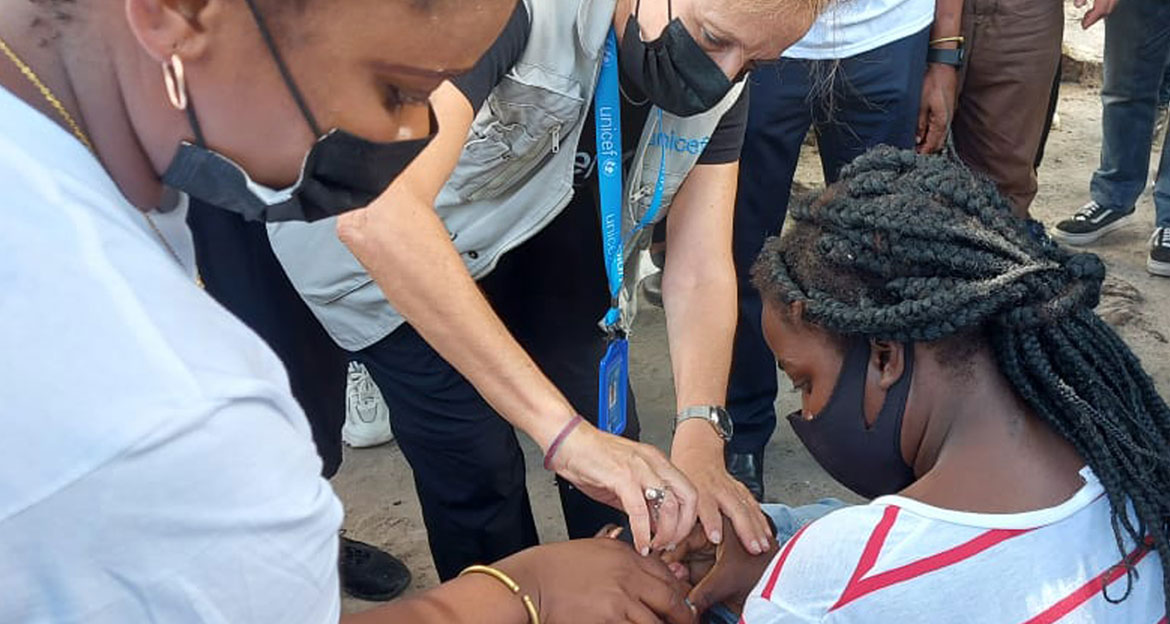
Outbreak at a glance
On 17 March 2023, the Burundi Ministry of Health declared a national public health emergency after reporting the detection of circulating vaccine-derived poliovirus type 2 from one case of acute flaccid paralysis (AFP) and five environmental samples. Local public health authorities are conducting a field investigation and an active search for additional AFP cases; a reactive immunization campaign is also planned.
Description of the outbreak
On 17 March 2023, the Burundi Ministry of Health declared a national public health emergency following the confirmation of a case of circulating vaccine-derived poliovirus type 2 (cVDPV2) in the country. The virus was isolated from a four-year-old, zero-dose male child with acute flaccid paralysis (AFP), from Bujumbura Rural province and from five cVDPV2-positive environmental samples from Bujumbura Mairie province, collected in November and December 2022. The case had the onset of paralysis on 24 November 2022. A stool specimen was collected on 27 November 2022 and was confirmed to be cVDPV2 on 13 March 2023. Sequencing results showed that the isolate has undergone eight to ten nucleotide changes. All the isolated viruses above are linked to a new emergence of cVDPV2, in Sud-Kivu, Democratic Republic of the Congo (DRC) [1].
According to the WHO UNICEF estimates of national immunization coverage, the coverage for both the oral poliovirus vaccine third dose (OPV3) and inactivated poliovirus vaccine first dose (IPV1) was 94% in 2021 in Burundi. However, the coverage of OPV3 and IPV1 was 63.4% and 56.6% respectively in the Health Centre of Gatumba where the index case is reported, according to the area coverage survey conducted during the case investigation.
These are the first instances of cVDPV2 linked with novel oral polio vaccine type 2 (nOPV2) since the roll-out of the vaccine began in March 2021. Nevertheless, all available clinical and field evidence continues to demonstrate that nOPV2 is safe and effective and has a significantly lower risk of reverting to a form that causes paralysis in low immunity settings when compared to monovalent oral polio vaccine type 2 (mOPV2). To date, close to 600 million doses of nOPV2 have been administered across 28 countries globally, and the majority of countries have seen no further transmission of cVDPV2 after two immunization rounds [1].
Epidemiology of Poliomyelitis
Polio is a highly infectious disease that largely affects children under five years of age, causing permanent paralysis (approximately 1 in 200 infections) or death (2-10% of those paralyzed).
The virus is transmitted from person-to-person, mainly through the fecal-oral route or, less frequently, by a common vehicle (e.g., contaminated water or food) and multiplies in the intestine, from where it can invade the nervous system and cause paralysis. The incubation period is usually 7-10 days but can range from 4-35 days. Up to 90% of those infected are either asymptomatic or experience mild symptoms and the disease usually goes unrecognized.
Vaccine-derived poliovirus is a well-documented strain of poliovirus mutated from the strain originally contained in OPV. OPV contains a live, weakened form of poliovirus that replicates in the intestine for a limited period, thereby developing immunity by building up antibodies. On rare occasions, when replicating in the gastrointestinal tract, OPV strains genetically change and may spread in communities that are not fully vaccinated against polio, especially in areas where there is poor hygiene, poor sanitation, or overcrowding. The lower the population’s immunity, the longer this virus survives and the more genetic changes it undergoes.
In very rare instances, the vaccine-derived virus can genetically change into a form that can cause paralysis as does the wild poliovirus – this is what is known as a vaccine-derived poliovirus (VDPV). The detection of VDPV in at least two different sources and at least two months apart, that are genetically linked, showing evidence of transmission in the community, is classified as ‘circulating’ vaccine-derived poliovirus type 2 (cVDPV2).
Public health response
An initial risk assessment (multi-country and regional), and field investigation both for the AFP case and the positive environmental samples have been completed by local and national public health authorities with support from partners of the Global Polio Eradication Initiative (GPEI), and a multi-country response plan has been developed. Burundi and DRC have scheduled initial vaccination campaigns to be conducted in May, and based on the ongoing risk assessment, supplementary immunization activities/vaccination campaigns will be conducted with the first round scheduled for 4-7 May and expected to be followed by two subsequent rounds in June and July 2023 targeting children under 7 years of age in Burundi. The vaccination campaign will be conducted in a synchronized way with bordering/neighbouring countries.
Additionally, surveillance for both AFP and environmental is being enhanced in the areas of detection, and the operationalization of further environmental surveillance sites is being evaluated, including bordering locations. Samples from Burundi, DRC, and neighbouring countries are also being prioritized for testing by the Global Polio Laboratory Network.
WHO risk assessment
The primary risk associated with any new cVDPV2 is gaps in routine immunization. The risk of further spread of such strains, or the emergence of new strains, is magnified by decreased immunization rates related to the ongoing COVID-19 pandemic. This event further highlights the risk of the international spread of cVDPV2 to neighbouring countries. There is no evidence that this virus poses a greater risk of spread, including international spread, than other VDPV2s that are derived from Sabin vaccines.
WHO advice
It is important that all countries, in particular those with frequent travel and contacts with polio-affected countries and areas, strengthen surveillance for AFP cases and commence planned expansion of environmental surveillance in order to rapidly detect any new virus importation and to facilitate a rapid response. Countries, territories and areas should also maintain uniformly high routine immunization coverage at the district level to minimize the consequences of any new virus introduction.
WHO’s International travel and health recommends that all travellers to polio-affected areas be fully vaccinated against polio. Residents (and visitors for more than four weeks) from infected areas should receive an additional dose of OPV or IPV within four weeks to 12 months of travel.
As per the advice of an Emergency Committee convened under the International Health Regulations (2005), the international spread of poliovirus remains a Public Health Emergency of International Concern (PHEIC). Countries affected by poliovirus transmission are subject to Temporary Recommendations. To comply with the Temporary Recommendations issued under the PHEIC, any country infected by poliovirus should declare the outbreak as a national public health emergency; ensure the vaccination of residents and long-term visitors; and restrict, at the point of departure, the travel of individuals who have not been vaccinated or cannot prove the vaccination status.
The latest epidemiological information on cVDPVs is updated on a weekly basis.
WHO does not recommend any travel and/or trade restrictions to Burundi based on the current information available for this event.
Further information
- Global Polio Eradication Initiative
- Poliomyelitis (Polio) Fact sheets
- WHO immunization dashboard
- GPEI Public health emergency status
- International travel and health
- Vaccine-derived polioviruses
- GPEI Statement on cVDPV2 detections in Burundi and Democratic Republic of the Congo
- Burundi declares outbreak of circulating poliovirus type 2
[1] GPEI Statement on cVDPV2 detections in Burundi and Democratic Republic of the Congo: https://polioeradication.org/news-post/gpei-statement-on-cvdpv2-detections-in-burundi-and-democratic-republic-of-the-congo/
Citable reference: World Health Organization (20 April 2023). Disease Outbreak News; Circulating vaccine-derived poliovirus type 2 (cVDPV2) – Burundi. Available at: https://www.who.int/emergencies/disease-outbreak-news/item/2023-DON457










